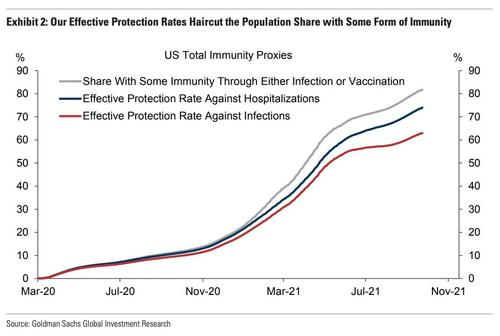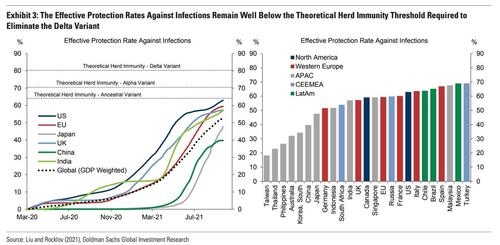Here Is How Immunity To COVID Varies By Country: Goldman
As evidenced by Goldman Sach's decision to cut its growth outlook for China to zero in the face of the unfurling energy crisis plaguing the world's second-largest economy with unexpected blackouts, the coronavirus is no longer the single biggest threat to global growth (particularly as Europe faces a potential energy crisis of its own).
That being said, gauging the global population's present (and projected) immunity levels is critical to an investment bank's broader global economic forecasts (along with being the subject of frequent client inquiries, we suspect). And so, after assiduously monitoring the global delta wave (with forecasts that have been mostly accurate with a few exceptions) Goldman's team is taking on the task of gauging global immunity. It's a hefty undertaking: after all, plenty of Democrats refuse to even acknowledge natural immunity, even as some studies have shown it might be even more effective against delta than the Pfizer jab.
Goldman's forecast relies on a few critical assumptions that are at least partly borne out by "the science":
-
Vaccine efficacy against hospitalizations remains close to 90% for most vaccines six months after vaccination.
-
This implies elevated effective protection rates against hospitalizations across most major economies, at around 70% in the US, the UK, and the Euro Area, 60% in China and India, 50% in Japan, and 65% on a global GDP-weighted basis, nearly 50pp higher than six months ago.
-
Presently, 80% of the American population now has some immunity through either vaccination or infection.
-
We find an effective protection rate against infections of around 60% in the US, the UK, and the Euro Area, 55% in India, 45% in Japan, 40% in China, and 50% on a global GDP-weighted basis, all below the theoretical herd immunity threshold required to eliminate the highly transmissible Delta variant.
Goldman points out that recent studies confirm that vaccine protection wanes over time and the rate varies by vaccine. But Goldman calculated an average rate and charted how odds of infection vs. hospitalization and death (which are much, much lower) decline over the first few months after vaccination.
Exhibit 2 shows Goldman's latest US immunity estimates. The analysts estimate that 80% of the American population now has some form of immunity through either vaccination or infection. Combined, that leaves us with an effective protection rate against infections of 60%.
Looking at the emerging world, immunity rates are understandably significantly lower - by roughly 20% on average compared with the US.
Here's how that breakdown looks for the developed world.
According to Goldman, their analysis effectively comes with some good news, and some bad news. The bad news is that, since herd immunity is effectively out of reach for humanity at this point, reviving certain types of economic activity like nightclubs, concerts, and other live events to their pre-pandemic levels will be difficult. The good news is at least humanity's resistance to COVID is improving, not degrading.
https://ift.tt/3CZKM4S
from ZeroHedge News https://ift.tt/3CZKM4S
via IFTTT





0 comments
Post a Comment